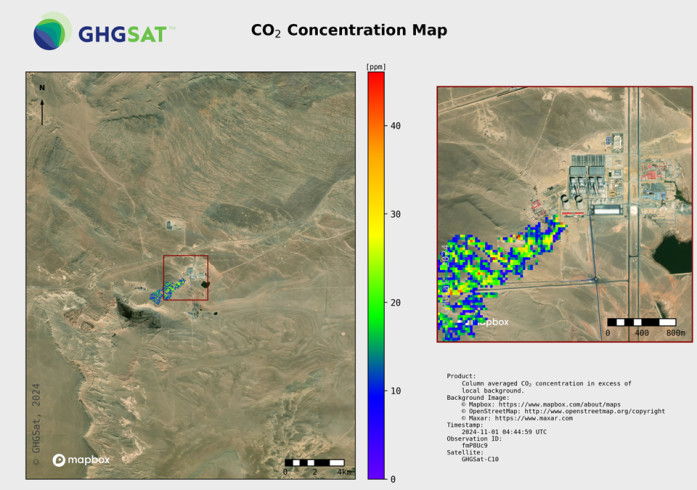The carbon dioxide plume, the first shared by GHGSat, was detected from a power-generating station, with an estimated rate of 12Mt of CO2 per year.
BAKU, AZERBAIJAN / ACCESSWIRE / November 14, 2024 / GHGSat, the global leader in satellite emissions monitoring, shared high-resolution images from Vanguard, the world's first commercial satellite designed to trace carbon dioxide to individual industrial facilities, for the first time at COP29.

A plume from Vanguard, the world's first commercial high-resolution satellite monitoring carbon dioxide, shared for the first time at COP29.
The carbon dioxide plume was detected from a power-generating station, with an estimated rate of 12 Mt of CO2 per year.
Released just as the international climate community convenes in Baku for the annual UN climate conference, the data marks a transformation in the way carbon dioxide emissions are monitored, reported, mitigated, and traded.
Recent research has shown that carbon dioxide emissions from burning fossil fuels are now 8% higher than 2015 levels, when the Paris Agreement that set landmark reductions targets for 2030 was first negotiated. Data like the observations from Vanguard, which zooms in to identify where exactly leaks originate, will be instrumental in pinpointing the sources and rates of those emissions, so that they can be effectively quantified and addressed.
"This detection is a critical first step toward a new era in monitoring emissions from space," said Stephane Germain, Founder and CEO of GHGSat. "Ultimately, the insights generated by Vanguard will empower industry operators and government regulators with precise data required to address carbon dioxide emissions, guiding the way to the ambitious emissions reductions needed to avoid the worst impacts of climate change."
GHGSat C-10, known as Vanguard, was launched in 2023, joining GHGSat's constellation of 11 methane-sensing satellites as the first of a new carbon-detecting fleet that GHGSat will put into orbit over the coming years. Data from the satellite will enable the standardized measurement of greenhouse gas emissions at sites from carbon-intensive industries, such as steel mills, cement plants, and oil & gas facilities, anywhere in the world. High-resolution CO2 data will also improve the accuracy of country-level emissions inventories and the Global Stocktake, and build confidence in the global carbon trading market, estimated to be approximately $1 trillion as it continues to develop.
GHGSat pioneered industrial greenhouse gas emissions monitoring from space in 2016, building a fleet of high-resolution satellites capable of tracing greenhouse gas emissions down to 25m-the area of an Olympic-sized swimming pool-and capturing methane emissions as small as 100 kg/hour at unmatched near-daily frequency.
Today, GHGSat serves as a trusted partner to the United Nations, NASA, the European Space Agency, and the governments of the United States, Canada and Great Britain, as well as multinational companies in carbon-intensive industries. In 2023 alone, GHGSat's constellation made over 3 million measurements across 85 countries. Since the beginning of GHGSat's journey, data from its satellite constellation has enabled mitigation of methane emissions equivalent to the annual emissions of nearly 3.5 million gasoline-powered cars on U.S. roads.
Contact Information
Alison Boyer
Director of Communications
aboyer@ghgsat.com
SOURCE: GHGSat
View the original press release on newswire.com.